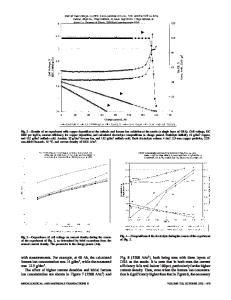The fluidized bed electrowinning of silver
- PDF / 430,088 Bytes
- 5 Pages / 603.28 x 783.28 pts Page_size
- 55 Downloads / 332 Views
I.
|
|
INTRODUCTION AND
PREVIOUS
INVESTIGATIONS
THE Zadra cell is commonly used to electrowin silver from aqueous cyanide solutions, l This cell employs an extended surface area cathode consisting of steel wool. The cell is operated in a semi-batch mode with periodic shutdown for manual removal of the silver and replacement of the steel wool. The cell suffers from the disadvantage that the cathode degrades as it undergoes a cementation reaction with the silver in solution. Consequently, the silver obtained from the cell is in the form of particles admixed with fragments of steel wool and must be subjected to further processing to yield bullion. A cell equipped with a cathode of fluidized silver particles appears to offer an attractive alternative to the Zadra cell; the former might be charged and discharged automatically and yield a silver product of the desired purity. The purpose of the investigation described here was to test the feasibility of this idea on a bench scale. Kreysa and Heitz 6 have investigated the fluidized bed electrowinning o f silver at lower current density than most of those used in the present investigation. Investigations where other metals have been deposited in such electrodes are tabulated in Reference 3.
~--Anode Feeder
Anoly t e Outlet
Catholyte - Outlet
Diaphragm
oo ~
Fluidb
. 4 . * . * * ,-,
9
.-.
_
Bed /
II.
l_L
EXPERIMENTAL APPARATUS AND PROCEDURE
Figure 1 depicts the 50 amp cell used in this investigation. The cell employs a cathode consisting of a bed of fluidized particles. The cathode chamber had horizontal dimensions of 63 mm • 19 mm (in the direction of current flow). When expanded, the cathode bed height was 150 mm; 25 pct bed expansion was used in all runs. Fluidization is maintained by pumping the silver containing electrolyte up through the bed. To the left of the fluidized bed is the current feeder which serves as the electrical connection to the particles. Throughout this investigation a 4 mm thick graphite current feeder (located at the side of the cathode chamber away from the diaphragm) was used. Occasionally in fluidized bed electrowinning a problem of metal deposition on the current feeders is observed, but no T. HUH, Graduate Student, and J. W. EVANS, Professor of Metallurgy, are with the Department of Materials Science and Mineral Engineering, Hearst Mining Building, University of California, Berkeley, Berkeley, CA 94720. C. D. CAREY is Senior Staff Metallurgist with Homestake Mining Company, 1726 Cole Boulevard, Golden, CO 80401. Manuscript submitted October 29, 1982. METALLURGICALTRANSACTIONS B
-o
,-
--
--
9
b --
// /
/
/ n
-
_ $ n
i
Flow Distributor
7 7P
Inlet
Inlet
Fig. 1--Side view of cell used in this investigation. VOLUME 14B, SEPTEMBER 1983--353
Table I.
Analysis, Homestake Solution
Analysis of Cyanide Solution Ag Cu Pb Zn Co C1 A1 Ni As Sb (mg/1) (mg/1) (rng/1) (mg/1) (mg/1) (mg/1) (mg/1) (mg/l) (mg/1)(mg/1) 200. 81. 3.6 840. 0.9 I 0.3 3.4 I 2.1 Note: I = Interferenceprecludes determination of As and C1. such pro
Data Loading...











